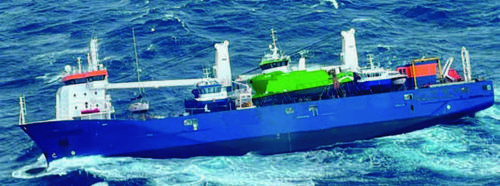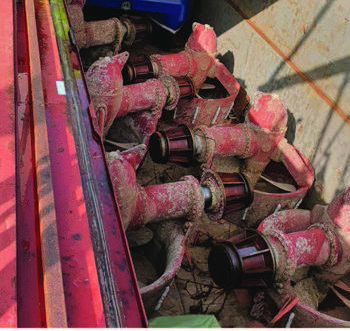202441 Securing heavy cargo – details matter
As edited from the Dutch Safety Board report issued July 2022
A multi-purpose cargo vessel was transporting six azimuth thrusters in its hold, each thruster weighing 60 tonnes. Stowage calculations based on the voyage instructions and stowage plan were made by an officer and checked by the Master before loading. The results were sent to the office for approval.
According to the calculations, each thruster would require 10 lashings. To be on the safe side, the Master and crew decided to use 12 or more lashings for each thruster. Based on the load capacity of the lashings, it was decided that ‘cargo stoppers’ (metal plates placed tightly to the underside of the cargo and welded to the deck to help prevent shifting) were not required.
During the voyage, the weather conditions were in line with the forecasts. On the day of the occurrence the northwesterly wind was up to 40 knots. The measured wave heights were a bit higher than predicted, at 7.5 metres early in the day, reaching 10.8 metres by late afternoon. The vessel reduced speed and changed course into the swell, keeping the vessel’s rolling manageable.
The next morning, a bilge high level alarm (HLA) for the cargo hold sounded twice within 30 minutes. The bilge pumps were activated, and the bilge was visually inspected. There was a significant amount of water in the hold, but it was unclear what had caused the water ingress.
An officer and the cargo superintendent went together to check the cargo hold. They found a large quantity of water and noticed that the three forward stowed azimuth thrusters had been dislodged. One of these three had come loose first and had caused a domino effect, causing the other two to shift as well. The thrusters had punched a hole in the port side anti-heeling tank. This had originally been full, but its contents were now running into the hold.
Measures to dewater the hold were not successful and soon the vessel was listing to about 30 degrees. The Master, concerned for the safety of the vessel, broadcast a Mayday and eight of the twelve crew members were evacuated. The remaining four crew members tried to keep the vessel in a stable condition but late in the afternoon they too were evacuated.
The following day the list was now about 45 degrees, and the wind was causing the vessel to slowly approach the coast. As the vessel neared the coast a tug line was secured and the vessel safely towed to a nearby port of refuge.
The report notes that the information about the cargo of azimuth thrusters provided by the freight broker to the operator did not contain any specific instructions for loading, unloading, lashing or any detailed information on lashing points. The chartering department did not request more detailed and specific loading instructions and presumed that the information it had received was sufficient to perform proper lashing of the azimuth thrusters. The discrepancy between the available information and the required information made it difficult to devise an adequate and symmetric lashing system.


Lessons learned
- Even though ‘extra lashing’ was used, one azimuth thruster nonetheless broke free and caused others to also come adrift. Lashing can only do so much when cargo pieces are extra heavy, as in this case. In hindsight, cargo stoppers should also have been welded at the bases.
- An inland route would have been a safer alternative to sailing across open sea under the predicted weather conditions.
- Heavy cargo items deserve extra attention and detailed lashing plans. For quality assurance, the final lashing state could be observed by a qualified third party.
